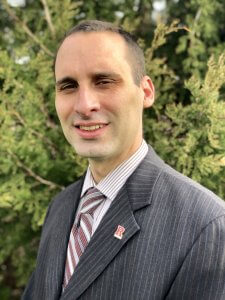
Dr. Patrick Szary, Associate Director of CAIT, has served on the executive committee of CUTC previously as well playing an instrumental role in leading the Center. Photo ©Dr. Patrick Szary.
The Associate Director of CAIT, Dr. Patrick Szary, was recently elected Vice President of CUTC for 2021-2022. Dr. Szary leads CAIT’s research efforts helping to align them with USDOT’s national vision and the needs of stakeholders in the Northeast region. He has been a member of CUTC’s executive board previously, most recently serving as Secretary last year.
At its summer meeting this June, the Council of University Transportation Centers (CUTC) elected Dr. Patrick Szary, associate director of the Rutgers Center for Advanced Infrastructure and Transportation (CAIT), as its Vice President for 2021-2022.
Last year Dr. Szary served as CUTC secretary, helping to lead and steer the organization through unprecedented times during the COVID-19 pandemic. Now, Dr. Szary and fellow members will have the challenge of continuing to lead CUTC as the nation recovers from the pandemic and begins to return to normal. In previous roles, Dr. Szary also served on the CUTC Executive Committee from 2014-2017 and before that was selected for the CUTC-ARTBA Administrative Leadership Award.
“I look forward to continuing to serve on the CUTC executive board this year as its new Vice President,” Dr. Szary said. “The COVID-19 pandemic shifted the way that we live, work, and commute during the past 15 months, and has brought about new challenges and questions that must be addressed to maintain our nation’s infrastructure and transportation networks. By continuing to work closely with CUTC during this time I hope to help the organization address these challenges and give back to the transportation research community.”
The goal of CUTC is to promote university transportation research, education, workforce development, and technology transfer initiatives, and to raise the profile of university transportation centers through innovative and impactful research conducted at centers across the nation.
As associate director of Rutgers CAIT, Dr. Szary has been integral to the Center’s success since its inception as a USDOT University Transportation Center in 1998—as well as helping it grow into the current Region 2 UTC focused on the “Durability and Extending the Life of Transportation Infrastructure.”
He has also generated more than $30 million in funding for CAIT and has published more than 50 research reports and journal articles. Some of his recent work has included supporting local Transit agencies as they develop COVID-19 responses during the pandemic and test new technologies for enhanced safety on public transit vehicles. Overall he has worked to align CAIT’s research to meet national visions as well as regional needs such as better pavement, new technologies such as UAS, and more, through his leadership and engagement with stakeholders and decision makers in the transportation industry.

